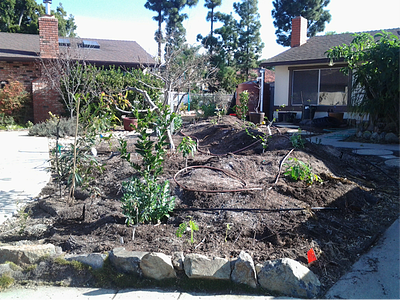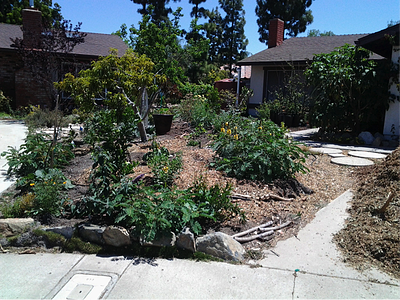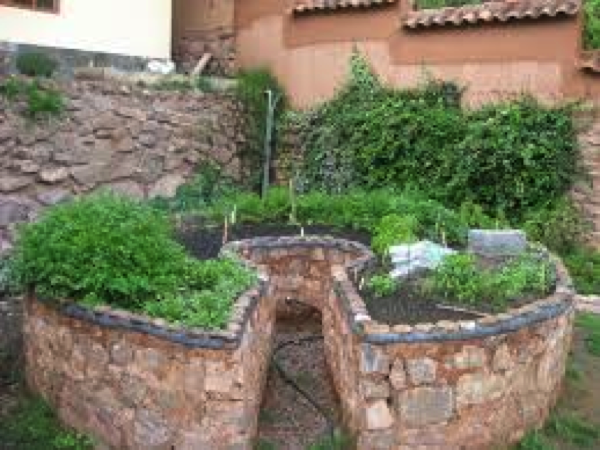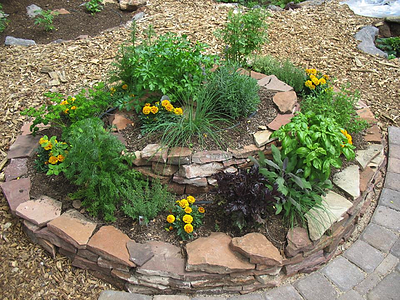
One of my favorite topics to explore when teaching ecologic design and permaculture courses is how math concepts and principles offer insight and inspiration into how we design and manage our lands. While this can quickly extend to a life-long study of patterns and the mathematics of nature, let’s focus on one of the goals for many home-scale gardeners:
Today we’ll examine how slopes and shapes can help us create more surface area, which leads us to some interesting and pleasing answers to this common question/opportunity.
Creating slope via mounds and depressions often creates more drama and aesthetic appeal. Once we use contours, creating high and low points with slopes in between, we also create more surface area than flat land provides. An additional benefit to building raised and sunken beds with elevation changes: We create microclimates through having a sunny/warmer side, a shady/cooler side, dry spots at the top, and moisture-retaining spots at the bottom.
My general advice — don’t rush to build that next set of raised garden beds, unless the soil is very poor or accessibility is important in your design considerations. It is usually a surprise to people when I suggest that sunken beds and raised paths are the way to go in arid landscapes. Think about it: The high spots dry quickly and the low spots retain more moisture. This is a paradigm shift for many … a very powerful one!
Below is a three-shot sequence of a 700-square-foot space in Southern California illustrating these ideas and more. It incorporates sloped mounds on a roughly east-west orientation and subterranean composting in order to create more surface area, increase microclimates, accumulate organic matter, and create a sponge-like soil capable of holding air and moisture for several months. Photos were taken this year on Jan. 8, May 14 and May 27 — talk about exponential growth!



In addition to these considerations of using slope to provide more space for plants through increasing surface area, the front yard pictured above offers fresh fruit or vegetables every day of the year and produces its own fertilizers through nitrogen-fixing- and nutrient-accumulating-plants!
Next, the shape of our garden space plays a huge role in how much area we have for plants. Not into traditional rows? Good — nature isn’t either, and that means we can fit more plants instead of paths into our space.
The classic permaculture shapes illustrating efficiency are the keyhole bed and herb spiral:

Keyhole Bed Photo: Urban Farm Consultants, LLC

Herb Spiral Installation and Photo: Josh Robinson, www.SDsustainable.org
Keyhole beds and herb spirals are examples of non-linear shapes that are both aesthetic and highly efficient. The herb spiral allows us to plant dozens of herbs or vegetables with different climate requirements (e.g., wet, dry, cool, warm) in close proximity in a very small space. Just as students can learn that a circle maximizes area for a given perimeter, gardeners can also learn that more plants are possible with a curved shape, such as a spiral, circle or keyhole. Notice linear gardens, agriculture fields and orchards are typically arranged to allow easy access for machines. However, if mechanized management is not a requirement, circular spaces are far more efficient: One can stand in the center of the keyhole and water, harvest and monitor (pests, plant health, etc.) all from one spot in the center. It conserves energy, minimizes “wasted” pathways and maximizes planting area. The keyhole bed and herb spiral are marvelous shapes that demonstrate using math in the garden!
One can expand on the simple cases and iterate, or nest, keyholes within each other, similar to a fractal pattern that some call a mandala garden:
 Image from Gaia’s Garden, by Toby Hemenway
Image from Gaia’s Garden, by Toby Hemenway
With a little bit of math, we can create beautiful multi-purposed landscapes full of natural bounty that are pleasing to the eye and the palate!
Ben Kotnik teaches Math, Hanna Somatics, Permaculture, Fruit Trees, Soils, Propagation and other related topics throughout Southern California. He was also manager of implementations at MIND Research Institute. All photos courtesy of Kotnik, except as noted.

MIND Research Institute welcomes guest blogs that highlight best practices in math education, blended learning and innovative learning strategies that inspire students at all ages.
Comment